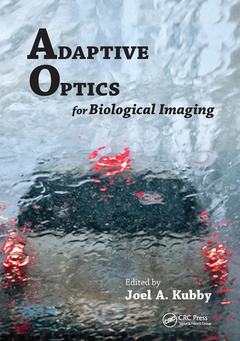Adaptive Optics for Biological Imaging
Coordonnateur : Kubby Joel A

Adaptive Optics for Biological Imaging brings together groundbreaking research on the use of adaptive optics for biological imaging. The book builds on prior work in astronomy and vision science. Featuring contributions by leaders in this emerging field, it takes an interdisciplinary approach that makes the subject accessible to nonspecialists who want to use adaptive optics techniques in their own work in biology and bioengineering.
Organized into three parts, the book covers principles, methods, and applications of adaptive optics for biological imaging, providing the reader with the following benefits:
- Gives a general overview of applied optics, including definitions and vocabulary, to lay a foundation for clearer communication across disciplines
- Explains what kinds of optical aberrations arise in imaging through various biological tissues, and what technology can be used to correct for these aberrations
- Explores research done with a variety of biological samples and imaging instruments, including wide-field, confocal, and two-photon microscopes
- Discusses both indirect wavefront sensing, which uses an iterative approach, and direct wavefront sensing, which uses a parallel approach
Since the sample is an integral part of the optical system in biological imaging, the field will benefit from participation by biologists and biomedical researchers with expertise in applied optics. This book helps lower the barriers to entry for these researchers. It also guides readers in selecting the approach that works best for their own applications.
Principles: Principles of Wave Optics. Principles of Geometric Optics. Theory of Image Formation. Methods: Aberrations and Benefit of Their Correction in Confocal Microscopy. Specimen-Induced Geometrical Distortions. Simulation of Aberrations. Overview of Adaptive Optics in Biological Imaging. Wavefront Correctors. Adaptive Optics System Alignment and Assembly. Applications: Indirect Wavefront Sensing: Sensorless Adaptive Optics for Microscopy. Implementation of Adaptive Optics in Nonlinear Microscopy for Biological Samples Using Optimization Algorithms. AO Two-Photon Fluorescence Microscopy Using Stochastic Parallel Descent Algorithm with Zernike Polynomial Basis. Pupil-Segmentation-Based Adaptive Optics for Microscopy. Applications: Direct Wavefront Sensing: Coherence-Gated Wavefront Sensing. Adaptive Optics in Wide-Field Microscopy. Biological Imaging and Adaptive Optics in Microscopy. Adaptive Optical Microscopy Using Direct Wavefront Measurements. Index.
Joel Kubby is the Department Chair of Electrical Engineering in the Baskin School of Engineering at the University of California at Santa Cruz. His research is in the area of microelectromechanical systems (MEMS) with applications in optics, fluidics, and BioMEMS. Before joining the University of California at Santa Cruz in 2005, he was an area manager with the Wilson Center for Research and Technology and a member of technical staff in the Xerox Research Center Webster in Rochester, New York (1987–2005). Prior to Xerox, he was at the Bell Telephone Laboratories in Murray Hill, New Jersey, working in the area of scanning tunneling microscopy.
Date de parution : 06-2020
17.8x25.4 cm
Date de parution : 05-2013
17.8x25.4 cm
Thèmes d’Adaptive Optics for Biological Imaging :
Mots-clés :
Adaptive Optics System; Wavefront Sensor; adaptive optics; Zernike Mode; aberrations; Dm; optical aberrations; microscopy; Pupil Plane; confocal microscopes; Lenslet Array; wide-field microscopes; Wavefront Correction; two-photon microscopes; Shack Hartmann WFS; diffraction; Strehl Ratio; MEMS; Wavefront Aberration; fluorescence; Liquid Crystal Spatial Light Modulator; wavefront; Zernike Polynomials; Shack-Hartmann; Aberrated Wavefront; super resolution; Focal Spot; Spherical Aberration; Relay Telescope; Mem DMs; Amplitude Psf; Wavefront Error; Mirror Segments; Psf; Spatial Light Modulator; Surface Micromachining; Data Set



